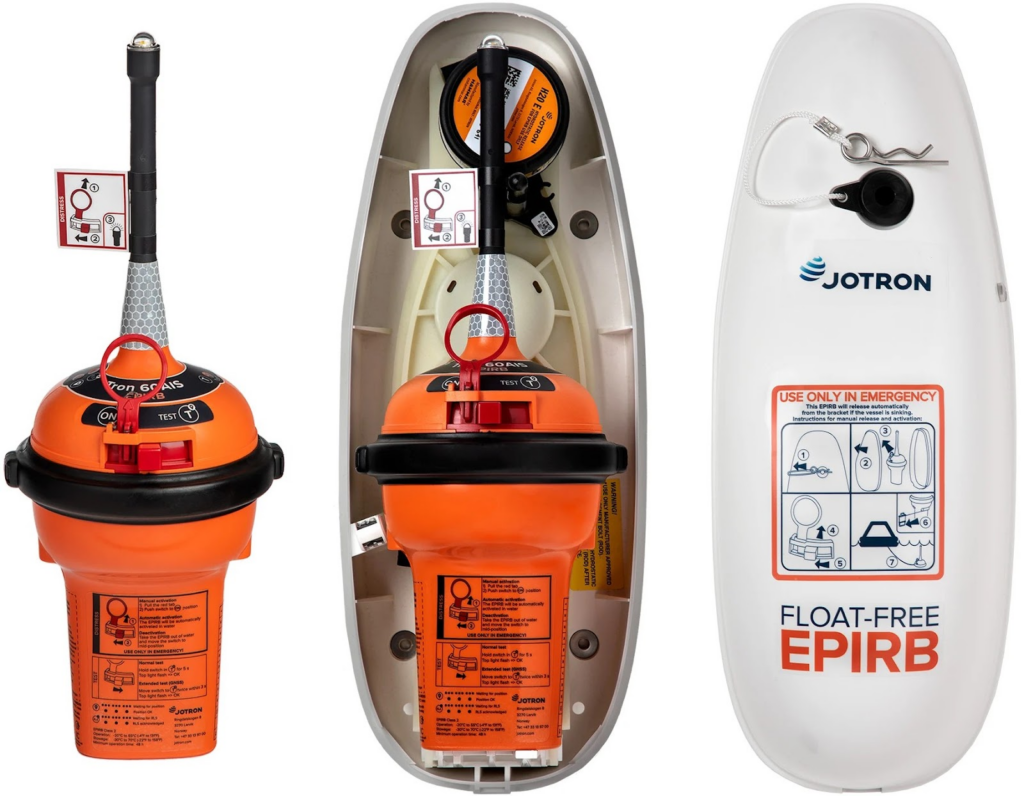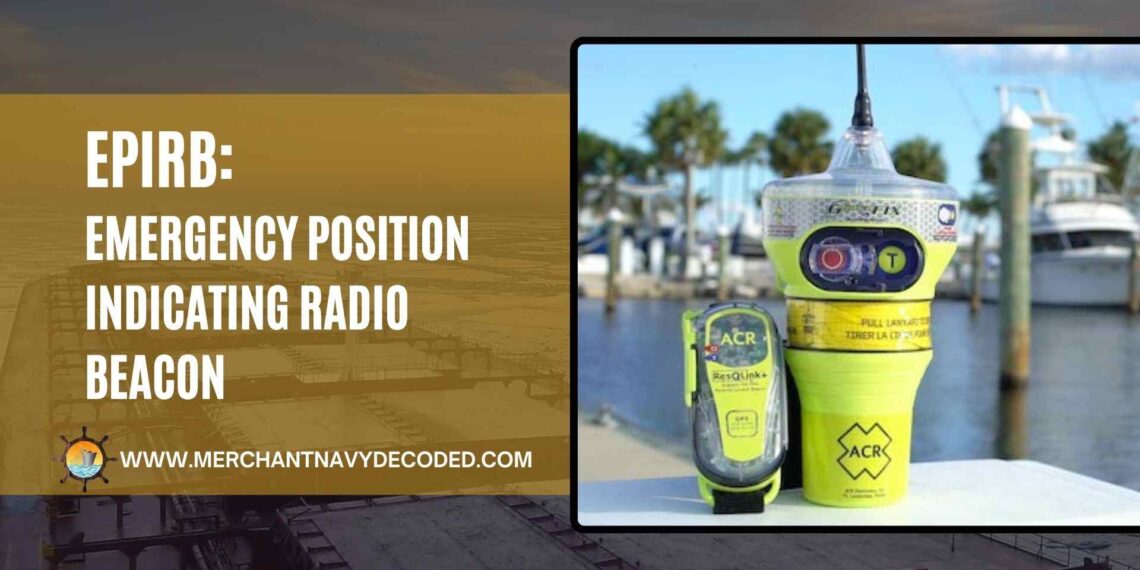What is Emergency Position Indicating Radio Beacon (EPIRB)
1:- What is an EPIRB?
An Emergency Position Indicating Radio Beacon (EPIRB) is a crucial piece of safety equipment found on ships, boats, and aircraft. It’s specifically designed to send out an automatic distress signal when activated during an emergency, helping rescue teams locate the vessel swiftly. An EPIRB is your lifeline when stranded or in danger at sea, ensuring a rapid response and rescue operation.
2:- EPIRB Meaning

Think of an EPIRB as the emergency SOS button for your vessel. If your boat gets lost or faces danger, activating the EPIRB sends a distress signal via satellites. These satellites communicate with rescue teams, providing your exact location and signaling the need for immediate help. This makes an EPIRB essential for anyone traveling by sea, as it guarantees assistance even in remote locations where other communication tools may not work.
3:- EPIRB Functions

- Distress Signal: When activated, an EPIRB sends a powerful distress signal detectable by satellites orbiting Earth.
- Satellite Detection: Satellites receive the signal and determine the source of the distress.
- Location Pinpointing: Using GPS technology, satellites pinpoint the vessel’s exact location.
- Alerting Rescue Authorities: The satellite information is sent to ground stations, alerting rescue authorities like the Coast Guard.
- Initiating Rescue Operations: Rescue teams use the location data to coordinate and dispatch search and rescue missions.
4:- How Does an EPIRB Work?
4.1. Activation
- Manual Activation: Most EPIRBs are manually activated by crew members during an emergency by pressing a button or pulling a pin.
- Automatic Activation: Some EPIRBs activate automatically when submerged or if the vessel capsizes.
4.2. Signal Transmission
- Distress Signal: Once activated, the EPIRB transmits a distress signal on the 406 MHz frequency, monitored by satellites specifically for emergency use.
- Data Transmission: In addition to the distress signal, the EPIRB may transmit information such as vessel identification, number of people on board, and emergency details.
4.3. Satellite Detection
- Global Network: EPIRB signals are detected by satellites forming a global network designed for monitoring maritime distress signals.
4.4. Location Determination
- GPS Technology: Modern EPIRBs incorporate GPS to determine and relay the vessel’s precise location, ensuring quick and accurate detection.
4.5. Ground Station Reception
- Data Reception: Ground stations receive and analyze the distress signals from satellites before alerting appropriate rescue teams.
4.6. Rescue Coordination
- Information Sharing: Rescue authorities receive detailed information, enabling them to initiate search and rescue operations efficiently.
5:- When Should You Use an EPIRB?
EPIRBs should be activated in life-threatening situations, such as:
- Vessel capsizing or sinking.
- Unmanageable medical emergencies requiring evacuation.
- Fires on board that can’t be controlled.
- Severe weather conditions threaten crew safety.
Avoid misusing the EPIRB, as it triggers a full-scale search-and-rescue operation. Only activate it when other communication options, like VHF radio, are unavailable or inadequate.
6:- EPIRB Frequencies
EPIRBs transmit primarily on the 406 MHz frequency, accompanied by a secondary 121.5 MHz homing signal.
6.1. EPIRB 406 MHz
- Satellite-based: This frequency is dedicated to satellite detection, allowing global coverage and pinpointing the vessel’s location.
- Global Reach: Due to satellite networks, 406 MHz EPIRBs provide worldwide coverage, ensuring help is accessible wherever the vessel is.
6.2. EPIRB 121.5 MHz
- Homing Signal: Historically used for aircraft and marine search operations, this frequency assists in locating the distress signal within a shorter range.
7:- EPIRB Range
The newer 406 MHz EPIRBs are designed for accuracy and global reach, offering pinpoint accuracy within 2-5 kilometers, compared to older models with a 25-kilometer range. They utilize a specialized frequency and work with both polar-orbiting and geostationary satellites, enhancing response times and coverage.
8:- Types of EPIRB
EPIRBs come in various types suited for different vessels and situations:
8.1. Class A EPIRB

- Highest Performance: Offers the longest transmission range and advanced features like position reporting.
- Designed for Commercial Vessels: Typically used on larger ships and commercial vessels, and is mandatory in many regions.
8.2. Class B EPIRB

- Cost-Effective: More affordable than Class A, suitable for smaller boats and recreational vessels.
- Shorter Range: Has a reduced transmission range and may lack advanced features.
9:- EPIRB Regulations and Testing
9.1. Regulations for EPIRB
- SOLAS Convention: The International Convention for the Safety of Life at Sea (SOLAS) mandates EPIRBs for specific vessels, depending on size, type, and operating area.
- National Requirements: Individual countries may enforce additional regulations for EPIRB use, testing, and maintenance.
9.2. Testing Procedure
- Preparation: Ensure the EPIRB is in a well-ventilated area.
- Activation: Activate the EPIRB in test mode as per manufacturer instructions.
- Signal Verification: Listen for the alarm and check visual indicators.
- Satellite Check: Some models require testing with a satellite simulator.
- Battery Check: Verify battery status and log results in the maintenance records.
10:- EPIRB vs. SART
While both devices ensure maritime safety, there are key differences:
- Activation: EPIRBs typically activate automatically, while SARTs are manually operated.
- Frequency: EPIRBs transmit at 406 MHz, whereas SARTs operate at 9 GHz.
- Range: SARTs are effective in nearshore and shallow water, while EPIRBs offer a global range.
11:- Conclusion
EPIRBs (Emergency Position Indicating Radio Beacons) are essential for maritime safety, offering a reliable distress signal that ensures swift rescue operations. By understanding how EPIRBs work, the types available, and compliance with regulations, you can ensure your vessel is equipped to protect you and your crew. Regular testing and maintenance are crucial for keeping the EPIRB functional and effective. In an emergency, a well-maintained EPIRB could be the difference between life and death.
Disclaimer :- The opinions expressed in this article belong solely to the author and may not necessarily reflect those of Merchant Navy Decoded. We cannot guarantee the accuracy of the information provided and disclaim any responsibility for it. Data and visuals used are sourced from publicly available information and may not be authenticated by any regulatory body. Reviews and comments appearing on our blogs represent the opinions of individuals and do not necessarily reflect the views of Merchant Navy Decoded. We are not responsible for any loss or damage resulting from reliance on these reviews or comments.
Reproduction, copying, sharing, or use of the article or images in any form is strictly prohibited without prior permission from both the author and Merchant Navy Decoded.


